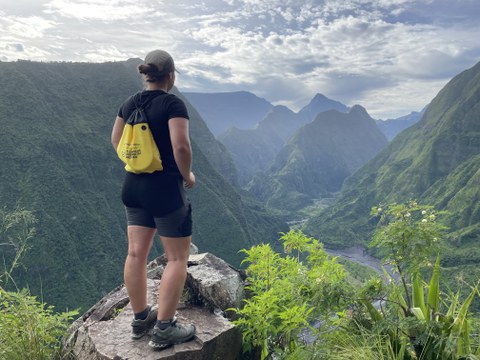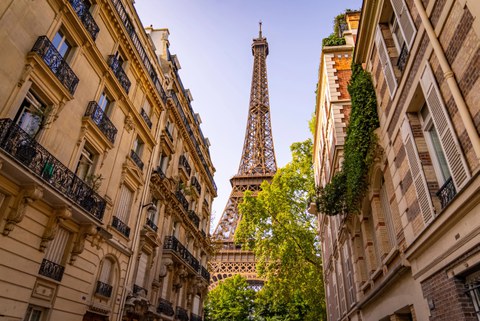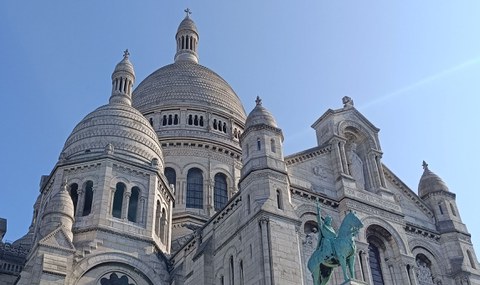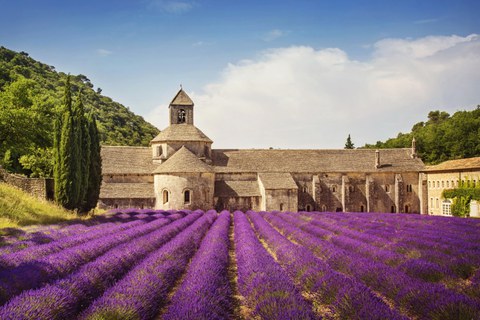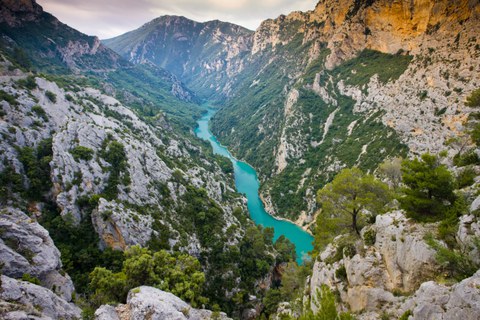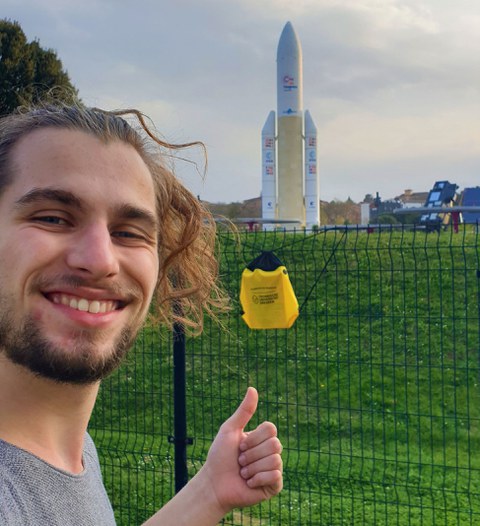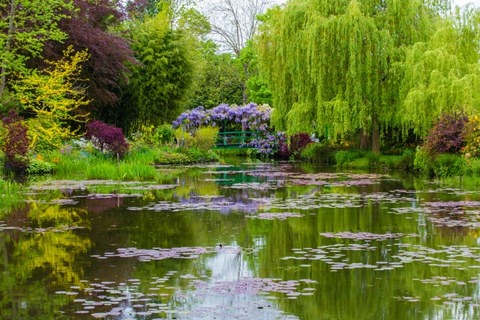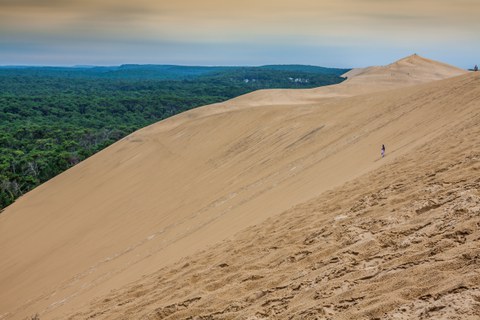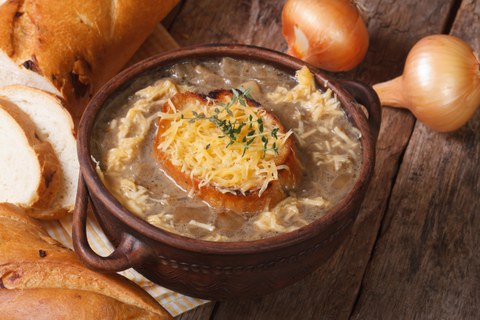Partner Country of the Month: France
Our western neighbor France is synonymous with art, culture and savoir-vivre. As the largest country in the EU, l'Héxagone is full of regional cultures and diverse landscapes, from the wild Atlantic coast to the cosmopolitan hustle and bustle of Paris and the lavender fields and rocky landscapes of southern France. TU Dresden has partner universities all over the country. What region are you most drawn to?
With the "Partner Country of the Month" campaign, we want to shine a spotlight on the wide diversity of countries, regions and partner universities of TU Dresden that our students can explore during a semester abroad.
Table of contents
General facts and figures about France
Capital: Paris
Population: 68.6 million (2025)
Official language: French
National holiday: July 14, commemorating the French Revolution
Currency: Euro
You can find more facts, figures and information on Wikipedia or at the German Federal Foreign Office. For travel info, see wikivoyage or france.fr.
Language matters
- Hello / See you – Salut
- Good morning – Bonjour
- How are you? – Ça va?
- My name is … – Je m’appelle …
- And you? – Et toi?
- Nice to meet you – Enchanté(e)
- Goodbye – Au revoir!
French is one of the most widely spoken languages in the world, with around 311 million speakers total, 80 million of which are native speakers (2025). On the one hand, this widespread use is a relic of the colonial era; on the other hand, French used to be the language of international diplomacy and aristocracy for centuries.
English is especially full of old French loanwords, as French nobility ruled England after the Norman Conquest in 1066. Often, the French loanwords are the fancier version of something that can also be expressed by another word – such as purchase and buy, mansion and house, encounter and meet. This will help you in learning French, but beware of false friends, like chair (flesh), déception (disappointment) or pain (bread).
France is one of the few countries where English proficiency is not sufficient for an exchange. Generally, you need French skills at B2 level in order to apply to one of our partner universities. Specific courses may also be available in English. Please check the exact requirements at your partner university of choice before applying.
There are many opportunities to learn French or refresh your rusty knowledge. In Dresden, TUDIAS, the VHS and the Institut Français offer French classes (may start from German). The Institut Français also organizes events (often free) where you can come into contact with French culture and language. Francophonie Dresden is also a good place to start speaking French.
Did you know that ....?
- the Eiffel Tower was supposed to get demolished after 20 years? As the tallest building in the world at the time, it was built for the 1889 World's Fair. In 1909, Paris decided to keep it because the tower proved useful in the growing field of radio communication. Today, it's still the most important radio and TV tower of the French capital. And, of course, the Eiffel Tower has come to symbolize Paris like nothing else - which would probably greatly surprise the artists who criticized the proposed tower as ‘unnecessary and monstrous’ and a ‘truly tragic street lamp’.
-
many French coastal resorts are named after (semi-) precious stones? The Côte d'Azur was the first to receive its poetic nickname, named after the azure blue of its sea and sky. Many other regions followed suit, with names such as Côte d'Emeraude (Emerald Coast), Côte de Nacre (Mother-of-Pearl Coast) and Côte d'Opale (Opal Coast).
-
time was decimalised during the French Revolution? A day consisted of 10 hours that were in turn divided into 100 minutes of 100 seconds each. The 7-day week gave way to 10-day décades, incorporated into a new calendar system. This was part of a broad attempt to replace feudal and Christian traditions with the values of the Enlightenment and an orientation towards natural constants. The new way of measuring time did not catch on – unlike decimalised currencies and the metric system, which also date back to the French Revolution.
- Y in northern France is the town with the shortest name in Europe? The inhabitants of Y call themselves Ypsilonien(ne)s.
-
France is the most visited country in the world, with currently around 100 million tourists per year? France has been ranked first place since the 1980s. Our neighbouring country can boast other records as well, including the largest art museum in the world (the Louvre), the highest mountain in Europe (Mont Blanc) and the highest number of roundabouts in the world (around 43,000).
-
turning baguettes upside down is bad luck? The origin of this superstition probably lies in medieval customs around executions. On the day of an execution, the baker reserved bread for the executioner by placing it upside down. Since then, upside-down bread – which in France usually means baguettes – has been associated with death and bad luck. So watch out! Let's end on a positive baguette fact: Magic wands are called baguette magique in French.
- in France, lavender is used not only as a fragrance, but also as an herb? In Provence, where lavender is widely cultivated, it’s a popular ingredient for desserts such as apricot tart with lavender or lavender ice cream. It can even be found in savoury dishes like fish or meat marinades.
Cooperation with universities in France
France is one of our most important cooperation partners. TU Dresden currently has exchange agreements with 64 universities located all over France. There is even one on the island of La Réunion near Madagascar. Our cooperations cover 30 different fields of study. So chances are good that your field of study is represented as well.
You can find all cooperations of TU Dresden at Mobility Online. This database also contains questionnaires detailing the experiences of our previous exchange students. Professors at your faculty with direct contacts to your partner university of choice can also give you helpful advice.
Find out more about Erasmus+ at TU Dresden and the contact persons and application deadlines for your faculty. All cooperations with French universities are organized via Erasmus+.
Don't miss...
Gorges du Verdon. Inland from the Côte d'Azur lies Europe‘s largest canyon. A turquoise-blue river has eaten its way through the limestone to a depth of several hundred meters. Take a hike along the Blanc Martel trail to enjoy the magnificent views as the path follows the course of the gorge, sometimes up on the rocks, sometimes descending down to the river. You can also go climbing, white-water kayaking, or swimming in the nearby lake. Gorges du Verdon is accessible via Moustiers Sainte-Marie, which is also worth a visit in its own right. With Mediterranean red-roofed houses set against an imposing mountainous backdrop, it‘s said to be one of the most beautiful villages in France.
Cité de l'Espace. Toulouse, capital of European space travel, has a fascinating theme park centered around space exploration. The exhibition contains many full-size models, including a prototype of the first space station Mir, which can be explored from the inside, and the ESA rocket Ariane. You can learn more about current ESA missions, the history of space travel, and its uses today, such as weather forecasting. Also, take a look at the events calendar, so you don't miss anything.
Musée de l'Orangerie. The Louvre is not the only Parisian art museum that's worth a visit. A comparatively small gem, the Musée de l'Orangerie mostly shows Impressionist paintings. The centerpiece of the exhibition are Claude Monet‘s water lily paintings. These gigantic panoramas -up to 17 meters wide- show the play of light and reflections on the artist's water lily pond. Like most Parisian museums, Musée de l'Orangerie charges no admission for EU citizens under the age of 26. And if you enjoy the paintings, why not go on a short trip from Paris or Rouen and visit Monet's famous garden and pond in the original?
Dune du Pilat. Close to our partner city of Bordeaux lies Europe‘s highest sand dune, piled up by the wind and currents of the Atlantic coast. At an impressive height of 100 meters, a width of 600 meters and stretching on for miles, the dune is slowly shifting towards the inland pine forests. The view of the sea on one and the forest on the other side is magnificent. In addition to that, you can admire the paragliders frequenting the dune – or try tandem jumping yourself!
Sainte-Chapelle is perhaps the most beautiful work of Gothic architecture, located right in the middle of Paris. Did you know that the gothic building style originated in France? This 13th century palace chapel is best to visit on a sunny day when the light shines through its huge stained glass windows. The dazzling blaze of color does not end there, as the vaulted ceiling and delicate window framing are ornately painted. Admission is free for EU citizens under the age of 26.
Let's cook...
Who doesn't think of croissants, baguettes, cheese, wine and crêpes when it comes to French food? These stereotypes are rooted in truth. Croissants are a typical typical choice for a small breakfast or snack. French cheese comes in 1,500 varieties and gets its own separate course in French meals. And wine is very popular not only as a drink, but also for cooking.
Each region in France has its own local cuisine with typical dishes and ingredients. Quiche and tarte flambée are specialties of the north east; apples, potatoes and butter are widely used in the north west; and olive oil, Provençal herbs and citrus fruits are popular in the south. In all regions, high quality food and eating with pleasure are highly valued.
As Christmas is approaching, have you ever asked yourself what a French Christmas dinner looks like? It’s definitely a sumptuous affair and usually consists of seven courses, starting with an apéritif and several entrées – smoked salmon, oysters or soup are popular choices. The typical main course is turkey stuffed with chestnuts, followed by a salad, cheeses and (at least in Provence) a total of 13 different classic desserts. And don’t forget the champagne!
Recipe: Soupe à l’oignon – French Onion Soup
This classic French onion soup is perfect for a cold winter’s day. First, you need to carefully caramelize the onions. Then you add stock, ladle the soup into ovenproof bowls, put in croutons or stale white bread – and, that’s right! – top it with plenty of cheese before putting it in the oven to grill. You can find a recipe here.
Contact and other contact persons
Did you have a great time in France? Do you have any tips for places and experiences not to be missed? We would be happy to share your experiences - here, via social media or, if you feel like it, at information events with other TUD students. Get in touch with us:
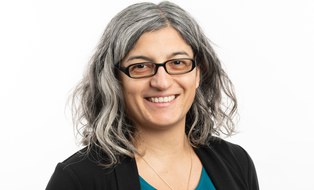 © Sven Ellger/TUD
© Sven Ellger/TUD
Advice on studying abroad
NameMs Federica Serra
Infocenter/ Study abroad; TUDworldwide: America
Send encrypted email via the SecureMail portal (for TUD external users only).
Visiting address:
Fritz Foerster Bau, Office 161 Mommsenstraße 6
01069 Dresden
Postal address:
TUD Dresden University of Technology International Office
01062 Dresden
Office hours:
- Tuesday:
- 09:30 - 11:30
- 12:30 - 14:30
- Thursday:
- 09:30 - 11:30
Please register at the SCS (FOE, floor 0).
Would you like to get first-hand information?
Want to find out more about France? Ask the TU Dresden alumni ambassadors, who are active in many countries around the world. They will be happy to give you tips and advice for your stay.
Contacting them is easy: on the interactive world map, markers show the cities where the alumni ambassadors live. A short profile with contact information is provided for each person.
Partner countries archive
Did you miss a partner country? No problem, here we collect all the pages for you to read.
|
Europe (Erasmus+) |
|
|
Africa |
|
|
America |
|
|
Asia |
|
|
Australia and Oceania |
|

